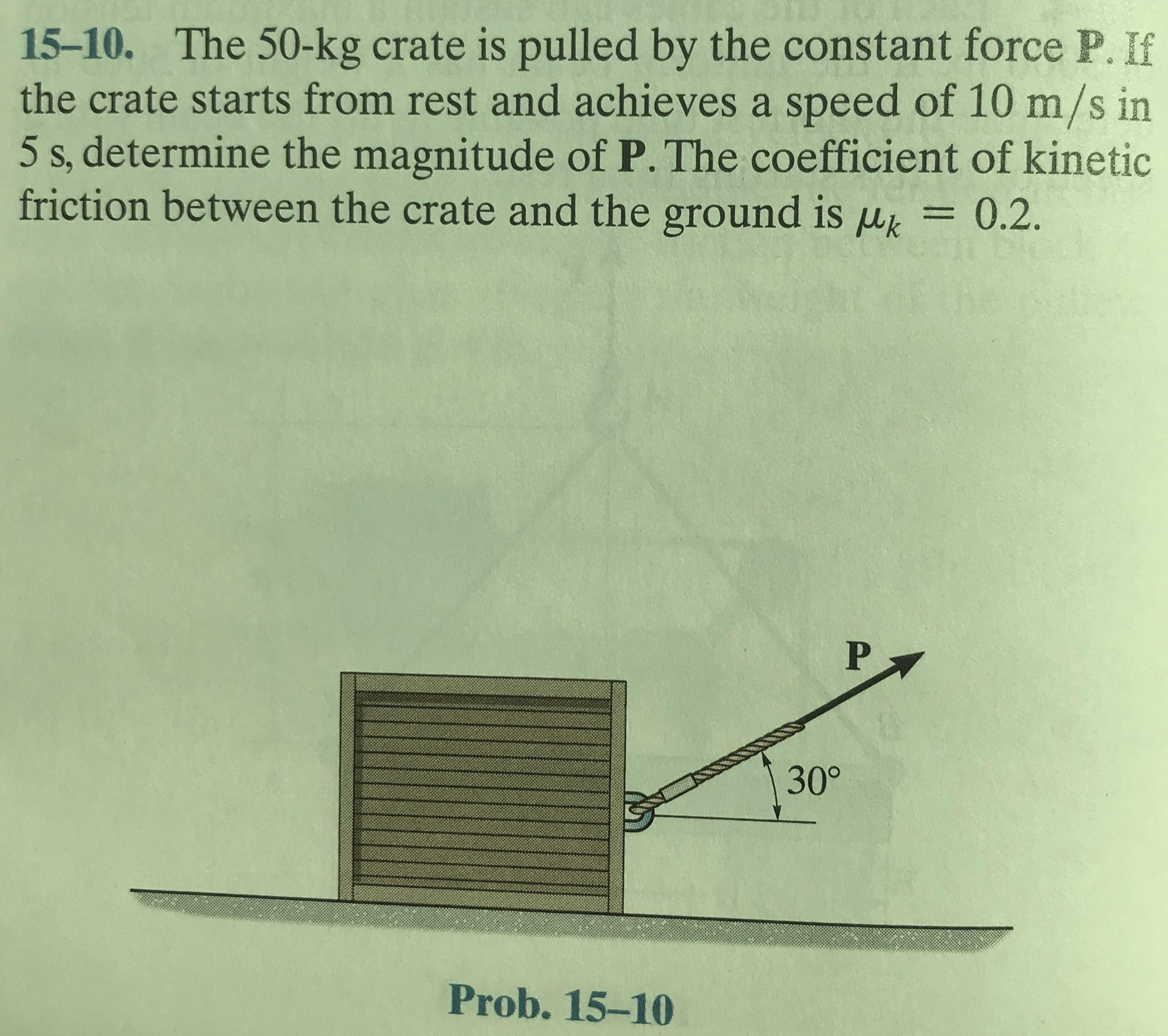
Elements Of Electromagnetics
7th Edition
ISBN: 9780190698614
Author: Sadiku, Matthew N. O.
Publisher: Oxford University Press
expand_more
expand_more
format_list_bulleted
Concept explainers
Question
Specifically a dynamics problem. Question in pic below.

Transcribed Image Text:15-10. The 50-kg crate is pulled by the constant force P. If
the crate starts from rest and achieves a speed of 10 m/s in
5 s, determine the magnitude of P. The coefficient of kinetic
friction between the crate and the ground is uk
0.2.
%3D
P
30°
Prob. 15-10
Expert Solution
This question has been solved!
Explore an expertly crafted, step-by-step solution for a thorough understanding of key concepts.
This is a popular solution
Trending nowThis is a popular solution!
Step by stepSolved in 2 steps with 3 images

Knowledge Booster
Learn more about
Need a deep-dive on the concept behind this application? Look no further. Learn more about this topic, mechanical-engineering and related others by exploring similar questions and additional content below.Similar questions
- 1 ) Derive a free body diagram with spring-mass-damper elements for given system. QUESTION 2 ) Derive equation of motion for given system in terms of m, c, k.arrow_forwardIn a nutshell, a smaller rock is propelled into the air as a huge counterweight in the back falls down, effectively converting gravitational potential energy into kinetic energy for the rock and the weight. But, since the rock is smaller.. it is propelled at a much faster velocity! Let's say we wanted to hurl a 50 kg boulder at a castle wall 100 meters away. Our wooden structure for the trebuchet is 10 meters tall, so that is the maximum distance the counterweight can fall. Assuming the launch angle is a perfect 45 degrees, and the boulder is released from ground level, derive the needed mass of the counterweight that will give the boulder enough kinetic energy to reach the base of the castle walls. You may assume no energy is "lost" due to friction, and ALL the counterweight's gravitational potential energy is converted into the boulder's kinetic enerqy. (HINT: You will need to employ 2D kinematics to find the needed final velocity, then use that final velocity in an energy equation…arrow_forwardA long, thin, wire of uniform cross-section has Young's Modulus Y and mass density D. When laid horizontally on a bench its unstretched length is L. One end is attached to a fixed point and the rest of the wire is allowed to hang freely and vertically in the earth's gravitational field. Find the extension of the lowest end of the wire (i.e., the wire's length additional to L) due to gravitational force. The acceleration due to gravity is g.arrow_forward
- For the simple pendulum shown in the figure, write the governing equation in s-domain. Assume small angles and linearize your model. Initial conditions are zero. Explain each step clearly. - 0(1) L, length m, massarrow_forwardIn the figure below Atwood’s machine is drawn - two masses and hanging over a massive pulley of rotational inertia and radius , connected by a massless unstretchable string. The string rolls on the pulley without slipping.a) Find the acceleration of the system and the tensions in the string on both sides of the pulley in terms of in terms of given variables.b) Why are the rope tensions on two sides of the pulley not the same? Explain it physically.c) Suppose mass and the system is released from rest with the masses at equal heights. When mass has descended a distance , find the velocity of each mass and the angular velocity of the pulley.[4***] A string is rolled around a cylinder( kg) as shown in figure. A person pulls on the string, causing the cylinder to roll without slipping along the floorarrow_forward
arrow_back_ios
arrow_forward_ios
Recommended textbooks for you
 Elements Of ElectromagneticsMechanical EngineeringISBN:9780190698614Author:Sadiku, Matthew N. O.Publisher:Oxford University Press
Elements Of ElectromagneticsMechanical EngineeringISBN:9780190698614Author:Sadiku, Matthew N. O.Publisher:Oxford University Press Mechanics of Materials (10th Edition)Mechanical EngineeringISBN:9780134319650Author:Russell C. HibbelerPublisher:PEARSON
Mechanics of Materials (10th Edition)Mechanical EngineeringISBN:9780134319650Author:Russell C. HibbelerPublisher:PEARSON Thermodynamics: An Engineering ApproachMechanical EngineeringISBN:9781259822674Author:Yunus A. Cengel Dr., Michael A. BolesPublisher:McGraw-Hill Education
Thermodynamics: An Engineering ApproachMechanical EngineeringISBN:9781259822674Author:Yunus A. Cengel Dr., Michael A. BolesPublisher:McGraw-Hill Education Control Systems EngineeringMechanical EngineeringISBN:9781118170519Author:Norman S. NisePublisher:WILEY
Control Systems EngineeringMechanical EngineeringISBN:9781118170519Author:Norman S. NisePublisher:WILEY Mechanics of Materials (MindTap Course List)Mechanical EngineeringISBN:9781337093347Author:Barry J. Goodno, James M. GerePublisher:Cengage Learning
Mechanics of Materials (MindTap Course List)Mechanical EngineeringISBN:9781337093347Author:Barry J. Goodno, James M. GerePublisher:Cengage Learning Engineering Mechanics: StaticsMechanical EngineeringISBN:9781118807330Author:James L. Meriam, L. G. Kraige, J. N. BoltonPublisher:WILEY
Engineering Mechanics: StaticsMechanical EngineeringISBN:9781118807330Author:James L. Meriam, L. G. Kraige, J. N. BoltonPublisher:WILEY

Elements Of Electromagnetics
Mechanical Engineering
ISBN:9780190698614
Author:Sadiku, Matthew N. O.
Publisher:Oxford University Press

Mechanics of Materials (10th Edition)
Mechanical Engineering
ISBN:9780134319650
Author:Russell C. Hibbeler
Publisher:PEARSON

Thermodynamics: An Engineering Approach
Mechanical Engineering
ISBN:9781259822674
Author:Yunus A. Cengel Dr., Michael A. Boles
Publisher:McGraw-Hill Education

Control Systems Engineering
Mechanical Engineering
ISBN:9781118170519
Author:Norman S. Nise
Publisher:WILEY

Mechanics of Materials (MindTap Course List)
Mechanical Engineering
ISBN:9781337093347
Author:Barry J. Goodno, James M. Gere
Publisher:Cengage Learning

Engineering Mechanics: Statics
Mechanical Engineering
ISBN:9781118807330
Author:James L. Meriam, L. G. Kraige, J. N. Bolton
Publisher:WILEY